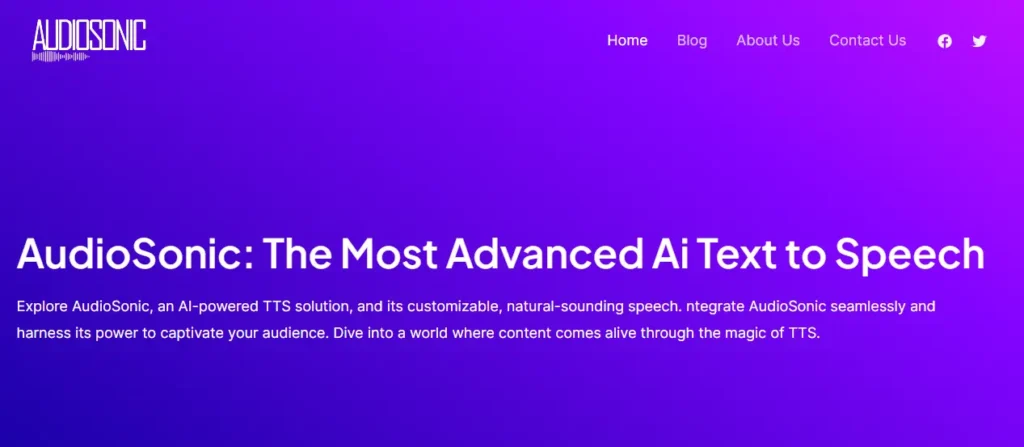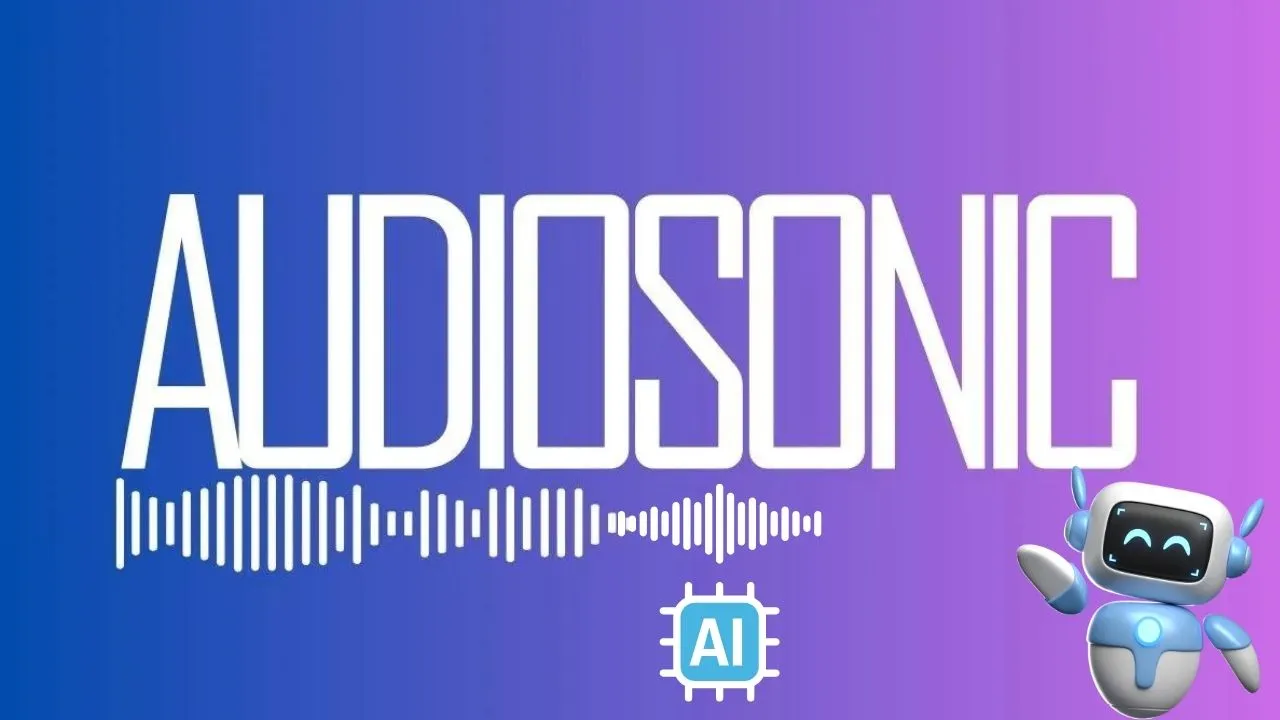One such groundbreaking technology is AI text-to-speech (TTS) technology, which has transformed the accessibility of written content for individuals all around the world. This article aims to provide a comprehensive review of AudioSonic, an AI Text to Speech tool that has gained significant popularity due to its advanced features and exceptional performance.

The Evolution of Text to Speech Technology
Text to Speech technology has come a long way since its inception. Initially, the synthesized voices sounded robotic and lacked the natural intonations and nuances of human speech. However, with the advancements in artificial intelligence and deep learning algorithms, AI Text to Speech technology has made remarkable progress.
Modern TTS systems, like AudioSonic, have overcome the limitations of their predecessors and can now generate human-like voices with remarkable accuracy and clarity.
Understanding the Benefits of AI Text to Speech Technology
AI Text to Speech technology offers numerous benefits across various industries and applications. One of the primary advantages is increased accessibility for individuals with visual impairments or reading difficulties. By converting written content into spoken words, TTS technology enables these individuals to absorb information more effectively.
Additionally, AI TTS technology enhances the user experience by providing a voice interface for various applications, such as virtual assistants, e-learning platforms, and customer service systems.
Exploring the Features of AudioSonic
AudioSonic stands out among other TTS tools due to its exceptional features and performance. With a vast library of high-quality voices in multiple languages and accents, AudioSonic provides users with a wide range of options to choose from. The voices generated by AudioSonic possess natural intonations, expressiveness, and are almost indistinguishable from human speech. Moreover, AudioSonic allows users to customize the speech rate, pitch, and volume, providing a truly personalized experience.
Another remarkable feature of AudioSonic is its multilingual support. It can seamlessly convert text into speech in various languages, making it a valuable tool for global businesses and international users. Whether it’s a podcast, a video game, or an e-book, AudioSonic ensures that the content can reach a diverse audience by offering accurate and natural-sounding translations.
How to Use AudioSonic for Various Applications
AudioSonic offers incredible versatility, making it suitable for a wide range of applications. For content creators, it can be an invaluable tool for producing engaging audiobooks, podcasts, and videos. By converting written content into spoken words, AudioSonic breathes life into the text, captivating the audience and enhancing their experience.
Moreover, businesses can leverage AudioSonic to enhance their customer service systems. By integrating TTS technology into their call centers or chatbots, businesses can provide a seamless and personalized experience to their customers. The natural-sounding voices generated by AudioSonic create a more human-like interaction, enhancing customer satisfaction and loyalty.
Case Studies: Real-Life Examples of AudioSonic in Action
To illustrate the practical applications and effectiveness of AudioSonic, let’s explore some real-life case studies. In the education sector, AudioSonic has been used to create interactive e-learning platforms. By converting textbooks into audio format, students with reading difficulties can easily access the content and learn at their own pace. This has resulted in improved comprehension and engagement among students, leading to better academic performance.
In the entertainment industry, AudioSonic has revolutionized the gaming experience. By integrating TTS technology into video games, developers can provide immersive and inclusive gameplay for visually impaired individuals. The realistic voices generated by AudioSonic bring the characters to life, creating a more immersive and enjoyable gaming experience.
Comparing AudioSonic with Other Text to Speech Tools
While there are several TTS tools available in the market, AudioSonic stands out due to its exceptional performance and advanced features. Unlike other TTS tools, AudioSonic offers a vast library of high-quality voices with natural intonations and expressiveness. This sets it apart from the robotic-sounding voices that are often associated with TTS technology.
Furthermore, AudioSonic’s multilingual support and accurate translations make it a top choice for businesses and content creators who want to reach a global audience. The customizable speech parameters allow users to tailor the voices according to their specific requirements, providing a truly personalized experience.
Tips for Maximizing the Potential of AudioSonic
To make the most out of AudioSonic and harness its full potential, here are some tips for users:
- Experiment with different voices: AudioSonic offers a wide range of voices to choose from. Try out different voices to find the one that best suits your content and target audience.
- Customize the speech parameters: Adjust the speech rate, pitch, and volume to create a voice that aligns perfectly with your content and desired effect.
- Consider the emotions: AudioSonic allows users to add emotions to the voices, making the speech more expressive and engaging. Experiment with different emotions to bring your content to life.
The Future of AI Text to Speech Technology
AI Text to Speech technology has already made significant advancements, and its future looks promising. As AI algorithms continue to improve, we can expect even more realistic and natural-sounding voices from TTS tools like AudioSonic. Additionally, the integration of AI TTS technology with other emerging technologies, such as virtual reality and augmented reality, holds great potential for creating immersive and interactive experiences.
Conclusion
In conclusion, AudioSonic is a game-changer in the field of AI Text to Speech technology. With its exceptional features, high-quality voices, and multilingual support, AudioSonic offers unmatched performance and versatility. Whether it’s for educational purposes, entertainment, or business applications, AudioSonic empowers users to unleash the power of spoken words and reach a wider audience.
FAQs
Q1. Can AudioSonic be used on mobile devices?
Yes, AudioSonic is compatible with various platforms and devices, including mobile devices. It provides a seamless user experience across different operating systems.
Q2. Is AudioSonic suitable for long-form content?
Absolutely! AudioSonic can handle both short and long-form content effortlessly. Its advanced algorithms ensure high-quality and consistent voice output, regardless of the length of the text.
Q3. Can I use AudioSonic for commercial purposes?
Yes, AudioSonic offers commercial licenses for businesses and content creators. It allows you to use the voices generated by AudioSonic for commercial applications, ensuring compliance with copyright and licensing regulations.
Q4. Is AudioSonic easy to integrate into existing systems?
Yes, AudioSonic provides comprehensive documentation and support for integration into various systems and platforms. The integration process is straightforward, and their technical team is available to assist with any queries or challenges.
Q5. Does AudioSonic support real-time text to speech conversion?
Yes, AudioSonic offers real-time text to speech conversion capabilities. This makes it suitable for applications such as live captioning, voice assistants, and interactive voice response systems.
- 1 The Evolution of Text to Speech Technology
- 2 Understanding the Benefits of AI Text to Speech Technology
- 3 Exploring the Features of AudioSonic
- 4 How to Use AudioSonic for Various Applications
- 5 Case Studies: Real-Life Examples of AudioSonic in Action
- 6 Comparing AudioSonic with Other Text to Speech Tools
- 7 Tips for Maximizing the Potential of AudioSonic
- 8 The Future of AI Text to Speech Technology
- 9 Conclusion
- 10 FAQs
